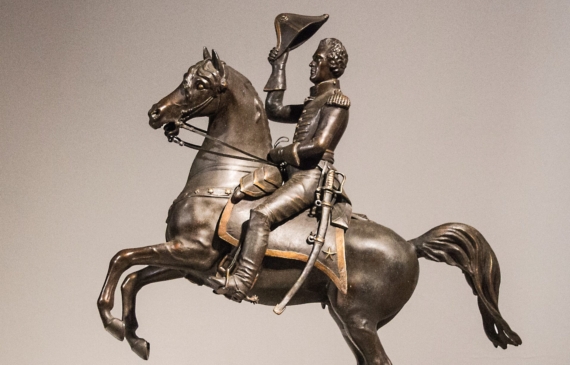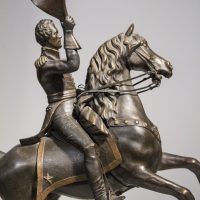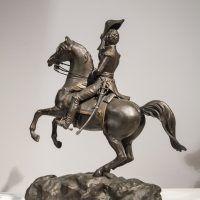




Clark Mills (American 1810–1883)
Andrew Jackson on Horseback, 1855
Zinc, brown patina and gold pigment
23 ¾ H. x 21 ⅝ W. x 7 ⅞ D. inches
Inscribed in high relief at right front vertical edge of self bronze base: PATENTED/ MAY 15 1855
Impressed at left center vertical edge of self bronze base:
CORNELIUS & BAKER/ PHILADELPHIA
Monuments:
Known collections:
Clark Mills, an innovative sculptor and bronze-caster of the mid 19th Century, was born in 1815 in Onondaga County, New York. He was orphaned at 5, and ran away from his uncle at the age of 13. He worked various jobs in Syracuse and New Orleans before settling in Charleston, South Carolina. After learning the stucco business Mills began his artistic career creating plaster busts based upon life masks.
In 1848 Mills was awarded the commission for the Andrew Jackson memorial in Lafayette Square, Washington, D.C. Mills depicted Andrew Jackson (1767-1845) as he appeared following the Battle of New Orleans, fought two weeks after the treaty to end the War of 1812 was signed. The United States was reluctant to send military support to protect the “western” lands (Tennessee and Kentucky), so Jackson paid for the Tennessee militia out of his own funds. He was later reimbursed by Congress, though not without great difficulties. Jackson went on to defeat the Spanish occupying Florida and served for a brief while as governor of the Florida Territory. The cannon surrounding the monument in Washington, D.C. are four rare Spanish cannons he captured in Pensacola. Five years later in 1853, the monument was unveiled on the anniversary of the battle of New Orleans. It was the first equestrian statue created by an American sculptor, and erected in the United States. It was cast at Mill’s foundry, less than a mile from its location, and was cast from cannons taken from the British during the war of 1812. This well received work helped Mills earn a reputation as a sculptor. Critics were impressed with the innovativeness, as it involved an ambitious and complex compositional design, with the horse in dynamic movement.
The city of New Orleans decided a second cast of Mills’ Monument would be fitting to commemorate the Battle of New Orleans and its famous Major General. At its dedication in Jackson Square, New Orleans, February 9, 1856, Mills addressed the crowd, describing the scene portrayed by the statue. On the morning of the battle Jackson raised his chapeau to return his troops’ salute, who had assembled for a review. His horse attempted to dart down the line, but Jackson pulled the reigns to hold the horse back, whose open mouth and curved neck displayed that he felt the bit in his mouth.
Several years later Mills sold a third cast to the city of Nashville, Jackson’s home state, and on May 20, 1880 it was unveiled at the State Capitol Square in Nashville, Tennessee.
Mills also produced a few reductions of this sculpture, cast by the Philadelphia foundry of Cornelius and Baker. These rare replicas bear the patent date of May 15, 1855, and are believed to have been presented to people who were instrumental in fundraising for the larger monuments. Fewer than a dozen are known in private collections.